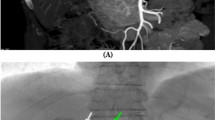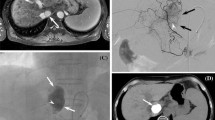Abstract
Purpose
To evaluate the origins of feeders of hepatocellular carcinoma (HCC) in the caudate lobe (S1).
Materials and Methods
Eighty-eight HCCs (mean diameter 21.4 mm) were treated by chemoembolization. The tumor-feeding caudate artery was confirmed when a tumor stain was demonstrated on angiogram and iodized oil was accumulated into the HCC and S1 on computed tomography (CT). The origins were divided into R1 (right proximal), R2 (right distal), L1 (left proximal), L2 (left distal), A (anterior segmental), P (posterior segmental), M (middle hepatic or medial segmental), Ph (proper hepatic), Ch (common hepatic), and Ex (extrahepatic). The origins of feeders supplying HCCs in the Spiegel lobe (SP; n = 36), the paracaval portion (PC; n = 38), and the caudate process (CP; n = 14) were also analyzed.
Results
One hundred sixteen feeders were identified: 11 (9.5%) arose from R1; 21 (18.1%) arose from R2; nine arose (0.9%) from L1; 15 (12.9%) arose from L2; 24 (20.7%) arose from A; 25 (21.6%) arose from P; seven (6.0%) arose from M; one (0.9%) arose from Ph; and three (2.6%) arose from Ex. HCCs in the SP and the PC were fed by feeders from both hepatic arteries (the ratios of right to left were 3:2 and 3:1, respectively), and HCCs in the CP were dominantly fed by feeders from the right hepatic artery.
Conclusion
The caudate artery most frequently arises from the right hepatic artery, followed with almost equal frequency by the left hepatic, the anterior segmental, and the posterior segmental artery. The origins of the caudate arteries differ according to the subsegmental locations.







Similar content being viewed by others
References
Takayasu K, Muramatsu Y, Shima Y et al (1986) Clinical and radiologic features of hepatocellular carcinoma originating in the caudate lobe. Cancer 58:1557–1562
Tanaka S, Shimada M, Shirabe K et al (2005) Surgical outcome of patients with hepatocellular carcinoma originating in the caudate lobe. Am J Surg 190:451–455
Shimada M, Matsumata T, Maeda T et al (1994) Characteristics of hepatocellular carcinoma originating in the caudate lobe. Hepatology 19:911–915
Shibata T, Maetani Y, Ametani F et al (2002) Efficacy of nonsurgical treatments for hepatocellular carcinoma in the caudate lobe. Cardiovasc Intervent Radiol 25:186–192
Seror O, Haddar D, N’Kontchou G et al (2005) Radiofrequency ablation for the treatment of liver tumors in the caudate lobe. J Vasc Interv Radiol 16:981–990
Yamakado K, Nakatsuka A, Akeboshi M et al (2005) Percutaneous radiofrequency ablation for the treatment of liver neoplasms in the caudate lobe left of the vena cava: electrode placement through the left lobe of the liver under CT-fluoroscopic guidance. Cardiovasc Intervent Radiol 28:638–640
Miyayama S, Matsui O, Kameyama T et al (1990) Angiographic anatomy of arterial branches to the caudate lobe of the liver: with special reference to its effect on transarterial embolization of hepatocellular carcinoma. Jpn J Clin Radiol 35:353–359 (in Japanese)
Terayama N, Miyayama S, Tatsu H et al (1998) Subsegmental transcatheter arterial embolization for hepatocellular carcinoma in the caudate lobe. J Vasc Interv Radiol 9:501–508
Yoon CJ, Chung JW, Cho BH et al (2008) Hepatocellular carcinoma in the caudate lobe of the liver: angiographic analysis of tumor-feeding arteries according to subsegmental location. J Vasc Intev Radiol 19:1543–1550
Mizumoto R, Suzuki H (1988) Surgical anatomy of the hepatic hilum with special reference to the caudate lobe. World J Surg 12:2–10
Suzuki H (1982) Correlation and anomalies of the vascular stricture in Glisson’s area around the hepatic hilum, from the standpoint of hepatobiliary surgery. Arch Jpn Chir 51:713–731 (in Japanese)
Miyayama S, Yamashiro M, Yoshie Y et al (2010) Hepatocellular carcinoma in the caudate lobe of the liver: variations of its feeding branches on arteriography. Jpn J Radiol 28:555–562
Kumon M (1985) Anatomy of the caudate lobe with special reference to portal vein and bile duct. Acta Hepatol Jpn 26:1193–1199 (in Japanese)
Matsui O, Kadoya M, Yoshikawa J et al (1993) Small hepatocellular carcinoma: treatment with subsegmental transcatheter arterial embolization. Radiology 188:79–83
Miyayama S, Matsui O, Yamashiro M et al (2007) Ultraselective transcatheter arterial chemoembolization with a 2-F tip microcatheter for small hepatocellular carcinomas: relationship between local tumor recurrence and visualization of the portal vein with iodized oil. J Vasc Interv Radiol 18:365–376
Miyayama S, Yamashiro M, Okuda M et al (2010) Main bile duct stricture occurring after transcatheter arterial chemoembolization for hepatocellular carcinoma. Cardiovasc Intervent Radiol 33:1168–1179
Miyayama S, Matsui O, Taki K et al (2005) Arterial blood supply to the posterior aspect of segment IV of the liver from the caudate branch: demonstration at CT after iodized oil injection. Radiology 237:1110–1114
Conflict of Interest
None.
Author information
Authors and Affiliations
Corresponding author
Rights and permissions
About this article
Cite this article
Miyayama, S., Yamashiro, M., Hattori, Y. et al. Angiographic Evaluation of Feeding Arteries of Hepatocellular Carcinoma in the Caudate Lobe of the Liver. Cardiovasc Intervent Radiol 34, 1244–1253 (2011). https://doi.org/10.1007/s00270-010-0036-3
Received:
Accepted:
Published:
Issue Date:
DOI: https://doi.org/10.1007/s00270-010-0036-3




